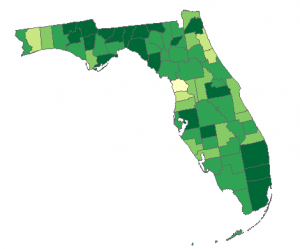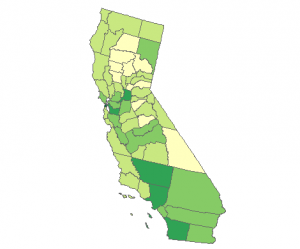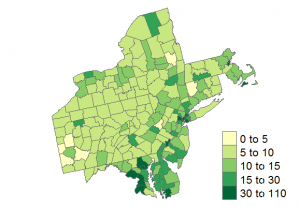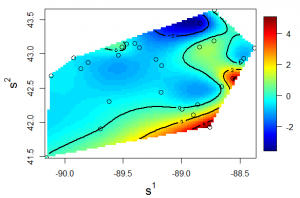Research Interests
- Spatial and Spatio-Temporal Analysis, Time Series Analysis
- Topics in Biostatistics
- Bayesian Hierarchical Models
- Copula approach to model complex spatial dependencies
- Spatio-temporal extremes
- Application to Public Health, Energy resources, Hydrogeology and to the Environmental, Chemical, Atmospheric and Climate sciences
Current Research
Spatio-temporal models for HIV/Zika/STI cases, social media features and behavioral patterns
Understanding the relationship between the HIV/Zika/STI events and the ever-growing social media data will allow researchers to better understand how the communication affects the spread of disease and further ensures an effective preventative measures. In collaboration with the Psychology and Computer Science departments at the University of Illinois at Urbana-Champaign and collaborators from the Health Department, Emory and John Hopkins University, etc, we plan to develop space-time models for disease cases using the influence of online communication and available and available social, economic and behavioral variables. We are particularly interesting in modeling spatial extremes to be able to better identify potential disease outbreaks via social media. This work was initiated and is supported by the Social Action Lab at University of Illinois.
A Spatially-varying autoregressive prediction model for HIV
The Centers for Disease Control and Prevention (CDC) has reported that although the number of newly diagnosed cases of HIV has declined by 19% overall in the last decade, progress has been uneven as diagnosed cases have become more prominent in some demographic groups such as African Americans and in particular geographic regions such as the southern part of US (http://www.cdc.gov/hiv). Because the rate of infection shows a highly spatially and temporally varying pattern, we are appropriately using modeling techniques that incorporate the space and time variability along with demographic covariates. A major challenge with modeling HIV data lies in the rarity of the disease, leading to few to no incidents across much of the domain. This also makes it necessary to borrow strength from neighboring regions in both space and time in order to more accurately estimate the underlying disease risk. Motivated by making prediction for HIV new diagnosis rate based on a HIV dataset that is abundant in space but has short length in time, we have built a class of spatially varying autoregressive models (SVAR), fit in a Bayesian hierarchical setting, for this purpose and apply these models to three regional datasets of the United States. We also employ copula methods to describe complex spatial dependencies. The model allows for spatial and temporal correlation as well as space-time interaction. It also allows us to estimate the evolution pattern of the diagnosis rate at county level.
Predicted 2015 HIV rates by county.
Methods Implemented: Bayesian hierarchical modeling, MCMC sampling, spatial-temporal prediction, autoregressive models, mixed effects models, copula methods
Past Research
Modeling Nonstationary Space-Time Data with Dimension Expansion
Similar to image warping or convolution methods used to model nonstationary processes, dimension expansion has also been introduced by Bornn, Shaddick, and Zidek (2012) in Modeling Nonstationary Spatial Processes through Dimension Expansion. In collaboration with my advisor Dr. Bo Li, we extend this technique to spatio-temporal processes. This technique is based on the concept that a low dimensional nonstationary process to be represented as a stationary process in a higher dimension. It allows us to use the abundance of stationary models available and retain the nonstationary properties in the data. Both simulations and real data application to noisy streamflow and wind datasets show that modeling nonstationarity in both space and time, can improve the predictive
performance over stationary covariance models or the models that are nonstationary in space but stationary in time.
Estimated latent dimension in space of streamflow data.
Presented this work as a contributed paper at JSM Chicago 2016.
Methods Implemented: optimization algorithms, smoothing splines, likelihood estimation, spatial kriging methods
A Forecasting model for West Nile Virus infection of Mosquitos
I have also been working in collaboration with Dr. Marilyn O’Hara Ruiz in the pathobiology department of college of veterinary medicine to develop a real-time prediction model of mosquito infection rate for DuPage County, Illinois. It is unique in that it was developed using only time-lagged weather variables as predictors and will be used next summer to help make effective decisions about mosquito control. It is also making an impact in vector research as others are looking to apply the same model structure in other varying locales.
Methods Implemented: Regression modeling
Publications
Lyndsay Shand and Bo Li (2017). Spatially Varying Autoregressive Models for Prediction of New HIV Diagnoses. To be submitted.
Lyndsay Shand and Bo Li (2017). Modeling Nonstationarity in Space and Time. Biometrics. doi:10.1111/biom12656.
L. Shand; W. M. Brown; L. F. Chaves; T. L. Goldberg; G. L. Hamer; L. Haramis; U. Kitron; E. D. Walker; M.O. Ruiz (2016). Predicting West Nile Virus Infection Risk From the Synergistic Effects of Rainfall and Temperature. Journal of Medical Entomology. 1-10. doi: 10.1093/jme/tjw042.




